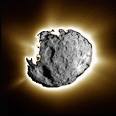
Amino acids that are the building blocks of life have been found in their highest ever concentration in two ancient meteorites which crashed to Earth millions of years ago, scientists claim.
Scientists believe their research, published online in the journal Meteoritics and Planetary Science, provides fresh insights into the origins of life on Earth.
Amino acids form the basis of proteins and enzymes, which are the building blocks of all biological life. They have been found in ancient carbon rich meteorites, which are fragments of asteroids formed shortly after the birth of the solar system.
The research team believes that the presence of amino acids in these meteorites provides clear evidence that the early solar system was richer in life’s raw materials than previously thought and that these materials may have helped to kick-start life on this planet.
Lead researcher, Dr Zita Martins, from Imperial College London’s Department of Earth Science and Engineering, explains: “We know that approximately 3.8 to 4.5 billion years ago the Earth underwent heavy bombardment from meteorites which brought molecules to our planet, just before life emerged on Earth. However, there is a gap in knowledge about how life came into being. Our work has shown that it may have been meteoritic amino acids and other biologically useful compounds that spurred life into existence.”
The team found amino acids in two ancient meteorites called CR chondrites, which were found in Antarctica in the 1990s. By analysing the carbon content of these meteoritic amino acids, the scientists were able to determine that, unlike Earth based amino acids which prefer a lighter variety of carbon, their samples were made from a heavier carbon which could only have been formed in space.
Dr Martins says her work provides new insights into the chemistry of the early solar system and the resources available for early life.
“Our increasing understanding of the materials available for the first living systems in the solar system suggests that we are all products of cosmic chemistry,” said Dr Martins.
Dr Zita Martins conducted her research whilst based at the Leiden University, Netherlands, in association with the Carnegie Institution of Washington and NASA JPL in the US.
Explanatory notes
1. “Indigenous amino acids in primitive CR meteorites”
The full listing of authors and their affiliations for the “Meteoritics and Planetary Science” paper is as follows:
Zita Martins (1, 2), Conel Alexander (3), Marilyn Fogel (3), Grazyna Orzechowska (4), Pascale Ehrenfreund (1)
(1) Leiden University
(2) Now at Imperial College London
(3) Carnegie Institution of Washington
(4) NASA JPL
A full copy of the paper can be downloaded on astro-ph at:
http://arxiv.org/abs/0803.0743v2
2. About Imperial College London
Imperial College London – rated the world’s fifth best university in the
2007 Times Higher Education Supplement University Rankings – is a science-based institution with a reputation for excellence in teaching and research that attracts 12,000 students and 6,000 staff of the highest international quality.
Innovative research at the College explores the interface between science, medicine, engineering and business, delivering practical solutions that improve quality of life and the environment – underpinned by a dynamic enterprise culture. Website: www.imperial.ac.uk
